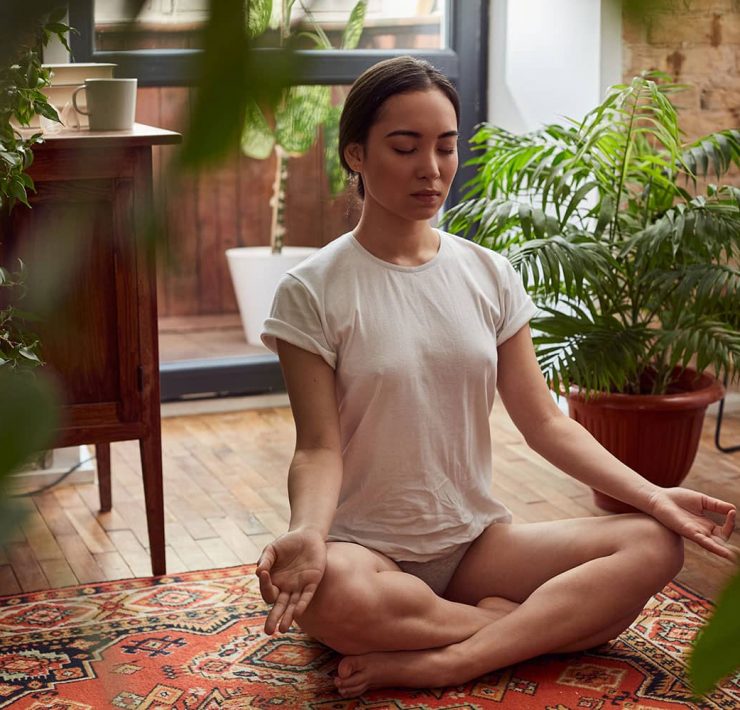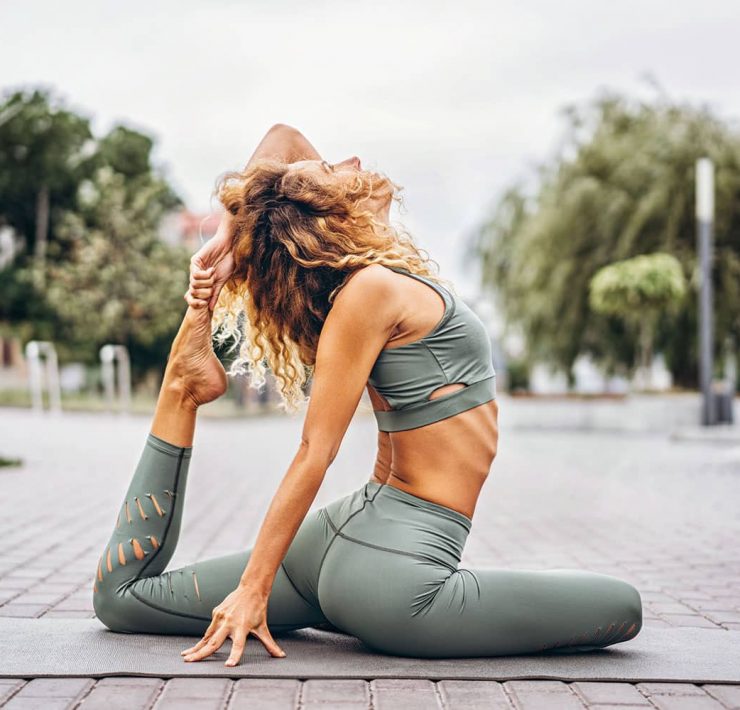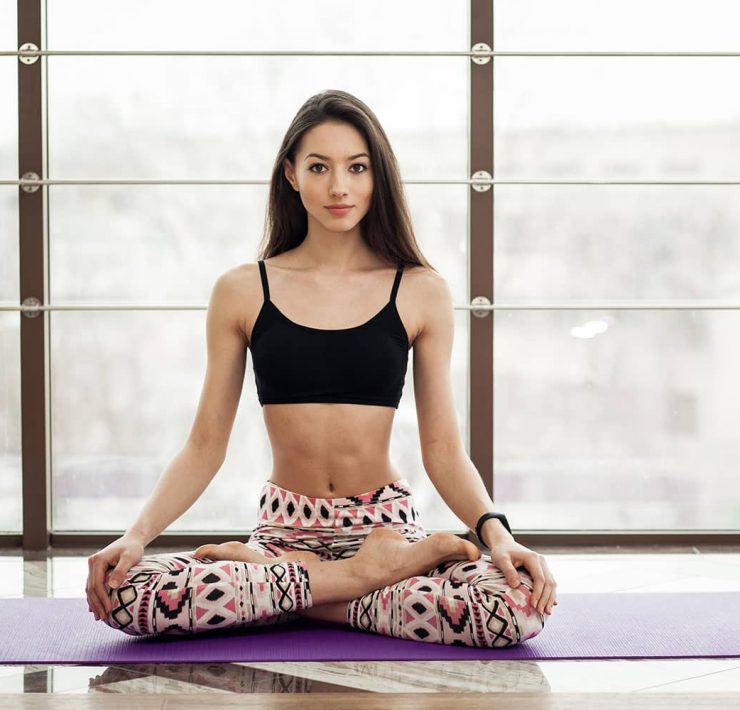
Paving the way for yogic living in Nebraska, Jacqueline Roberts…
Balance is the key to life. As students of yoga, we are fortunate to have our yoga practice and time on the mat to counter the hustle and bustle of life. Even in yoga, however, it is possible to lose balance and focus too heavily on one type of style. Yoga has such a rich history with differing styles, and you can use these different styles to balance your schedule and maintain a well-rounded practice. Yin yoga provides a slow and steady retreat from your energizing classes or other workouts. But, what exactly is yin yoga?
What is Yin Yoga?

Perhaps you have come across a yin yoga class at your local studio, or a restorative class, and been interested, but a little unsure of what this type of yoga offers. If you’ve peeked inside a yin session, you may see students lying in postures for several minutes, using props, and placing intent focus on breathing patterns and slight adjustments. You may have heard talk of”meridians” or “chi” and wondered what that meant in the world of yoga.
Yin yoga is a particular style of yoga that aims to balance the body’s main meridian system based on the ancient medical system of Chinese medicine. The asanas are strategically chosen to open and circulate blood and “chi” through the body to relieve stress, pain, and open blockages. Few poses are chosen for each session, and the poses are held for up to five minutes or longer. Much of the practice is done on the floor, either seated or lying down.
Why “Yin?”

In Taoist thought, everything can be divided into “yin” and “yang.” While yang is the active, warm, moving, bright, hard aspect of life, yin is the passive, cool, still, dark, soft and yielding aspect. Everything in nature is a composition of both yin and yang (even us humans) and when they are in balance, we flourish. Yin yoga is so called because it takes a slower, stiller approach and focuses on the more yin aspects of our body: the blood, connective tissue, and organs.
What is “Chi” and “Prana”

The terms are slightly different, but point to the same idea. Chi is a Chinese medicine term that represents the non-physical activating life force in the body, the oxygenation, the movement. Prana is a similar concept within the framework of Ayurveda and represents the life-giving power of the breath. Both chi and prana circulate through the body, and our bodies can suffer from a lack of or blockage of these forces. Similarly to the circulation of the blood, yin yoga promotes a circulation of these vital forces through the entire body. This helps to improve a vast range of health concerns from fatigue and minor aches and pains, to more serious diseases and conditions.
Why Yin Yoga?

Yin yoga not only provides a great balance in our yoga practices, but actually boasts many health benefits as well.
Balances the Mind and Body
Yin yoga is the perfect blend of meditation and physical movement. The slower style allows for a deeper focus, stretch, and relaxation. If you find that you have a hard time connecting to your physical body, yin yoga is the perfect practice to help you re-establish a strong balance between the two.
Reduces Stress and Anxiety
Many of us spend our days running around from here to there, work to school to home, appointments and outings and even off to yoga classes. The beauty of yin yoga is that it forces us to pause. We find release in the stillness and are able to settle down from our hectic lives. Many of the asanas in yin yoga help to relax the entire body and turn off the sympathetic nervous system. Yin provides a structured way to slow down.
Increases Circulation
Circulation is ever-important, as every cell in our body needs adequate nutrition and oxygenation from our blood. In addition to fostering a smooth and steady flow of blood to the entire body, yin yoga also stimulates the flow of “chi” or “prana,” our life force. Exercise is one of the easiest ways to improve your circulation of both blood and chi, but yin yoga helps to improve circulation at a deeper level. Many of the poses used in yin yoga work to target not just the muscles and joints, but the fascia layers and even the internal organs. This type of yoga is amazing to give these more intricate reaches of the body a flush of nutrient-rich blood and oxygen.
Improves Flexibility
Yoga in general will help you to come more supple and flexible, but yin tackles this issue head-on in an non-intimidating way. The poses in yin yoga are slow and build upon each other to help open areas of tension, release fascia constriction, relax trigger spots, and integrate the entire body. Yin is a great way to balance your more active sessions, like vinyasa, and to get a deeper stretch and flex in your asanas.
Releases Fascia and Mobilizes Joints
We’ve touched on this a bit already, but yin yoga shines when it comes to fascia. Fascia is a a web of connective tissue that integrates in the entire body. Throughout our daily lives, poor posture, bad habits, excessive sitting or standing, lack of stretching, injuries, and other factors can lead to toughness and congestion of the fascia. This then leads to issues like pain, tension, inflexibility, fibromyalgia, and other concerns. Yin yoga is one of the best ways to loosen and nourish your fascia, bringing it back to life. This connective tissue holds so much power in providing us with fluid movement and vitality, but it is often overlooked. Incorporate yin yoga into your routine to give your fascia some love.
Stimulates the Internal Organs
Deep breathing, inward focus, and strategic postures in yin yoga allow it to stimulate the internal organs, as well as our muscles and joints. Much of this has to do with the directed blood flow to the abdomen, as well as the general relaxation effect that occurs in the nervous system. With the body in parasympathetic mode, blood can gentle circulate through the internal organs, peritoneum, and deeper tissues of the body. This can provide amazing benefits for the digestive and reproductive systems – two systems that often suffer from the chronic stimulation of our stressed out sympathetic mode.
Who Should Practice Yin Yoga?

The short answer here is…anyone! Yin is a gentle, yet effective yoga style that can be adapted to any body type, age, condition, or other factor. Because it is geared towards regulating the deeper internal structures of the body, the physical movements are slower and more intentional. This makes it a fantastic place to start for beginners or those with health concerns.
While yin yoga can be useful for anyone, there are some who might find it particularly beneficial.
Stress and Anxiety
As we touched on above, yin yoga does a great job of integrating the body and mind and allowing for deep relaxation. This turns off the sympathetic system, giving our adrenal glands a rest and reducing the amount of cortisol, the stress hormone, in the body. Those who suffer from anxiety can find relief in the breathing techniques and balance between mind and body. Anxiety can often arise when we suppress our emotions. Yin yoga provides a dedicated time and space to acknowledge, process, and release these emotions in a physical practice.
Fertility or Gynecological Conditions
The reproductive organs often get the short end of the stick when it comes to the circulation of blood and chi. During stressful times (which can unfortunately be quite often for many of us) blood is directed away from the reproductive organs in favor of our muscles and decision-making brain. Yin yoga is the perfect remedy, as it not only helps to establish balanced flow of blood through the whole body, but can even be used to specifically target the reproductive organs. Many poses, such as Legs Up the Wall, shunt blood into this area and help to heal the tissues and improve flow throughout. Incorporate yin yoga into your routine if you suffer from painful periods or endometriosis, PCOS, amenorrhea, infertility, or other gynecological disorders.
Pain Conditions
Due to its ability to move blood, unblock areas of tension, and release the fascia, yin yoga is great for those who suffer from pain condition like migraines, fibromyalgia, or other generalized pain. Increased blood flow allows for better healing outcomes of damaged or stressed tissues and promotes pain relief and overall wellbeing.
Sleep Issues
If you suffer from insomnia, restlessness, or poor quality of sleep, yin yoga may be a fix. The relaxing nature of the practice can help you calm your mind and stimulate an appropriate sleep-wake cycle. You can adopt a few poses to practice right before bed for an even better night’s sleep.
Find Balance With Yin

Overall, yin yoga provides so many benefits to the entire body. It acts as the perfect balancing routine to an otherwise busy, hectic lifestyle. The gentle and relaxing style is not just a good excuse for a rest – yin yoga is a deep and intentional practice. You may find that it can be quite challenging, both physically and mentally.
Whether you need a little extra peace in your day or you have a specific issue you are working to resolve, yin yoga can be a great addition to your toolbox of natural therapies. Rooted in Chinese medicine and Ayurveda, yin has a huge healing potential for anyone. Begin by practicing a few asanas before bed or jump into a weekly class at the studio.
What's Your Reaction?
Paving the way for yogic living in Nebraska, Jacqueline Roberts is adored by her students as a constant source of support and inspiration. A knack for writing allows her to share what she has learned with the world.














